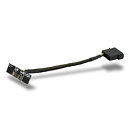Wednesday, December 22nd 2010

EVGA Intros Power Boost Gadget to Improve PCI-E Power Stability
EVGA released what it claims to be a handy little accessory that can increase PCI-Express slot power, improving overclocking stability of graphics cards installed. Called the EVGA Power Boost, the gadget is a tiny PCB that fits into the power-line notch of any PCI-Express slot (x1 thru x16), and draws in an auxiliary 12V line directly from the power supply unit. The little PCB draws in power from a standard Molex power connector, adding it to the motherboard's 12V line. EVGA also gave out a detailed HD video showing users exactly how to install the device, because inserting it into the wrong part of the PCI-Express slot will fry the motherboard. EVGA is asking $20 for it.


65 Comments on EVGA Intros Power Boost Gadget to Improve PCI-E Power Stability
My guess is the +12v wires are being load balanced, but the ground wires are simply connected to each other. As an example lets say each wire was rated to carry a unit of 1(going unit-less). Three +12v that are load balanced can carry a total of 3 units in. The ground units are simply connected together giving a variation of currents with the possible distribution of (.7,.8,1.5). One ground wire is now pulling 50% more current then its rated for. Add two more wires with the assumption that the two wires added pull the same current as the .7 above, then normalize the total current to 3: (.477,.477,.477,.545,1.02). The 1.5 current wire is now 1.02 which is just 2% over the rated current.
I know of nothing much that does not work as advertised in the Evga line-up. They have always been on top for a reason with their products as well as service. I find it gratifying that Evga does listen to overclockers and acts on their wishes from time to time. Maybe someone will document the advantages of this device and report the findings.
good board and good psu and this is not needed from the looks, hell i can't think of any way someone would need this unless they were runnin like 4 cards and other stuff
and 20 dollars, . . . . . damn
dont forget the 8 bucks to ship it :rolleyes:
Here's what I'd do: go to the electronics store, pick up a $10 soldering iron, $3 of lead/tin mix, and $7 of wire. There you go, and you can use that however you like.
I know on the SR2, and on the classified and on the Rampage 3, they have this feature built into the boards. But given that video cards have their own power source, but is this really going to work or is it needed, when the board doesn't come with it. I just don't see the point.:wtf:The killer 2100 actually works . .
I think the idea behind this is that if you have a cheap shitty PSU with poor power distribution over its 12V rails, you're using another rail to help boost the power to the PCI-E slot, reducing the chance of overloading one rail.
that said, i doubt a little thing like this could even handle enough power going through it to make a noticeable difference.
And my old ECS KA3-MVP had a power connector for the PCIe lanes, evga wasn't the first, as far as I knew, unless of course you are talking only within the scope of this generation of hardware?
I guess the joke about the electrons being exhausted after work and going for beer wasn't too funny.
I'm just trying to figure out what this thing's market is, and if it actually works.
I.E won't draw more than 75w from the powerlines anyway?
I mean even a pci-e 6 pin powercable can technically output the full 150w of the 8 pin if it wanted too ( the 8 pin just has two extra earths after all)
Although I suppose 480s would probably need to draw from everywhere when overclocked.
I don't know. Doesn't seem to me this has a very big niche to fill.
As chuchnit said this was designed to supplement power from the 24pin. Some people had their 24pin connector melt because nvidia and ati cards were drawing to much power through the pcie slots.
This is one of those things where I see the point, but at the same time, feel we probably shouldn't need to resort to this.
And the price is retarded.
As for the price I'm sure once you factor in the labor to make these, costs for making them, free shipping, and all the other costs associated with making these adapters they are close to the break even point.